Related Research Articles

The breast is one of two prominences located on the upper ventral region of the torso among humans and other primates. Both sexes develop breasts from the same embryological tissues. The relative size and development of the breasts is a major secondary sex distinction between males and females.

Megabats constitute the family Pteropodidae of the order Chiroptera (bats). They are also called fruit bats, Old World fruit bats, or—especially the genera Acerodon and Pteropus—flying foxes. They are the only member of the superfamily Pteropodoidea, which is one of two superfamilies in the suborder Yinpterochiroptera. Internal divisions of Pteropodidae have varied since subfamilies were first proposed in 1917. From three subfamilies in the 1917 classification, six are now recognized, along with various tribes. As of 2018, 197 species of megabat had been described.

A wet nurse is a woman who breastfeeds and cares for another's child. Wet nurses are employed if the mother dies, or if she is unable or chooses not to nurse the child herself. Wet-nursed children may be known as "milk-siblings", and in some societies, the families are linked by a special relationship of milk kinship. Wet-nursing existed in societies around the world until the invention of reliable formula milk in the 20th century. The practice has made a small comeback in the 21st century.

A mammary gland is an exocrine gland in humans and other mammals that produces milk to feed young offspring. Mammals get their name from the Latin word mamma, "breast". The mammary glands are arranged in organs such as the breasts in primates, the udder in ruminants, and the dugs of other animals. Lactorrhea, the occasional production of milk by the glands, can occur in any mammal, but in most mammals, lactation, the production of enough milk for nursing, occurs only in phenotypic females who have gestated in recent months or years. It is directed by hormonal guidance from sex steroids. In a few mammalian species, male lactation can occur. With humans, male lactation can occur only under specific circumstances.
A prolactin cell is a cell in the anterior pituitary which produces prolactin in response to hormonal signals including dopamine, thyrotropin-releasing hormone and estrogen, which are stimulatory. Prolactin is responsible for actions needed for body homeostasis, the development of breasts, and for lactation. The inhibitory effects of dopamine override the stimulatory effects of TRH in non-pregnant, non-lactating sexually mature females. Depending on the sex of the individual, prolactin cells account for 20% - 50% of all cells in the anterior pituitary gland. The inhibitory effects of dopamine override the stimulatory effects of TRH in non-pregnant, non-lactating sexually mature females. Other regulators include oxytocin and progesterone.
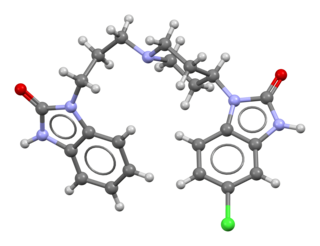
Domperidone, sold under the brand name Motilium among others, is a dopamine antagonist medication which is used to treat nausea and vomiting and certain gastrointestinal problems like gastroparesis. It raises the level of prolactin in the human body and is used off label to induce and promote breast milk production. It may be taken by mouth or rectally.
Galactorrhea or lactorrhea is the spontaneous flow of milk from the breast, unassociated with childbirth or nursing.

Breast engorgement occurs in the mammary glands due to expansion and pressure exerted by the synthesis and storage of breast milk. It is also a main factor in altering the ability of the infant to latch-on. Engorgement changes the shape and curvature of the nipple region by making the breast inflexible, flat, hard, and swollen. The nipples on an engorged breast are flat or inverted. Sometimes it may lead to striae on nipples, mainly a preceding symptom of septation mastitis.
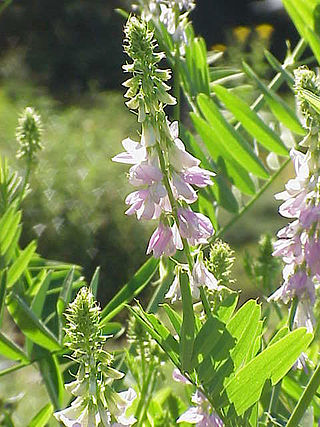
A galactagogue, or galactogogue, also known as a lactation inducer or milk booster, is a substance that promotes lactation in humans and other animals. It may be synthetic, plant-derived, or endogenous. They may be used to induce lactation and to treat low milk supply.

Crop milk is a secretion from the lining of the crop of parent birds in some species that is regurgitated to young birds. It is found among all pigeons and doves where it is also referred to as pigeon milk. Crop milk is also secreted from the crop of flamingos and the male emperor penguin, suggesting independent evolution of this trait. Unlike in mammals where only females produce milk, crop milk is produced by both males and females in pigeons and flamingos; and in penguins, only by the male. Lactation in birds is controlled by prolactin, which is the same hormone that causes lactation in mammals. Crop milk is a holocrine secretion, unlike in mammals where milk is an apocrine secretion. Crop milk contains both fat and protein, as with mammalian milk, but unlike mammalian milk, it contains no carbohydrates.

Lactational amenorrhea, also called postpartum infertility, is the temporary postnatal infertility that occurs when a woman is amenorrheic and fully breastfeeding.

The dayak fruit bat or dyak fruit bat is a relatively rare frugivorous megabat species found only on the Sunda Shelf of southeast Asia, specifically the Malay Peninsula south of the Isthmus of Kra, and the islands of Borneo and Sumatra. There are three species in the genus Dyacopterus: D. spadiceus, D. brooksi and D. rickarti. All are found in the forests of Malaysia, Thailand, and the Philippines. Few specimens of any of the three species exist, due not only to their rarity, but also because they rarely enter the sub-canopy of the forest where they can be caught in scientists' nets.

Erotic lactation is sexual arousal by breastfeeding on a female breast. Depending on the context, the practice can also be referred to as adult suckling, adult nursing, and adult breastfeeding. Practitioners sometimes refer to themselves as being in an adult nursing relationship (ANR). Two persons in an exclusive relationship can be called a nursing couple.

Machaonia is a genus of flowering plants in the family Rubiaceae. It has about 32 species. All are indigenous to the neotropics. None has a unique common name. Some species have been called "alfilerillo", a Spanish name for the common and well-known genus Erodium. The type species for Machaonia is Machaonia acuminata.
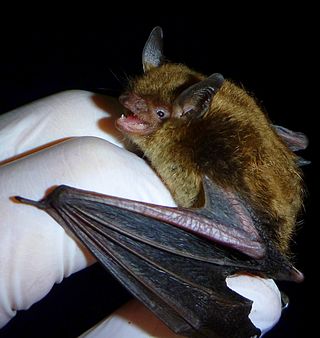
The little brown bat or little brown myotis is an endangered species of mouse-eared microbat found in North America. It has a small body size and glossy brown fur. It is similar in appearance to several other mouse-eared bats, including the Indiana bat, northern long-eared bat, and Arizona myotis, to which it is closely related. Despite its name, the little brown bat is not closely related to the big brown bat, which belongs to a different genus.
Feminizing hormone therapy, also known as transfeminine hormone therapy, is hormone therapy and sex reassignment therapy to change the secondary sex characteristics of transgender people from masculine or androgynous to feminine. It is a common type of transgender hormone therapy and is used to treat transgender women and non-binary transfeminine individuals. Some, in particular intersex people, but also some non-transgender people, take this form of therapy according to their personal needs and preferences.
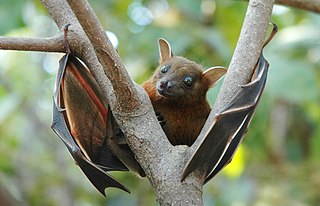
The lesser short-nosed fruit bat is a species of megabat within the family Pteropodidae. It is a small bat that lives in South Asia and Southeast Asia. It weighs between 21 and 32 grams, and measures 70 to 127 millimetres. It occurs in many types of habitat, but most frequently in disturbed forest, including lower montane forest and tropical lowland rain forest, plus gardens, mangroves, and vegetation on beaches.

Lactation describes the secretion of milk from the mammary glands and the period of time that a mother lactates to feed her young. The process naturally occurs with all sexually mature female mammals, although it may predate mammals. The process of feeding milk in all female creatures is called nursing, and in humans it is also called breastfeeding. Newborn infants often produce some milk from their own breast tissue, known colloquially as witch's milk.
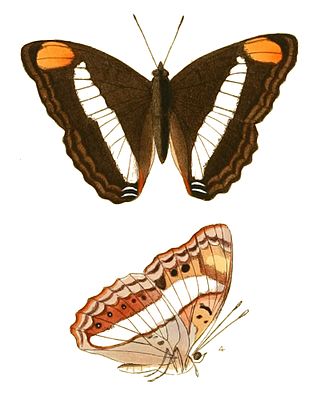
Doxocopa pavon, the Pavon emperor or Pavon, is a species of butterfly in the family Nymphalidae. They can be found from Paraguay in South America up to Texas in the southern United States. They are generally brown in their overall coloration, with two bands of white straddling the middle of the upper surfaces of the wings, and a patch of orange on the tips of their forewings. The upper surfaces of the wings of the males are overlaid by an iridescent blue-purple sheen. The females of the species closely resemble members of the unrelated genus Adelpha.
In aquatic mammals, maternal transfer is the movement of contaminants from mother to offspring, typically of lipophilic contaminants while in utero or through the mother's milk. This has become important with the increase in usage of persistent organic pollutants (POPs). POPs biomagnify due to their lipophilic nature and become accumulated in the lipid tissues of aquatic mammals. These lipids are used as energy for the mother during the development of offspring, which releases the POPs into the circulatory fluid. This leads to a transfer of the toxicants into the developing embryos during gestation as well as into milk that an aquatic mammal produces during lactation.
References
Citations
- ↑ Voyage de Humboldt et Bonpland; 1-3. Voyage aux régions équinoxiales du Nouveau Continent : fait en 1799, 1800, 1801, 1803 et 1804. Tome 1 / par Al. de Humboldt et A. Bonpland; rédigé par Al. de Humboldt; J. Smith (Paris), 1814-1825, p. 376, (Online at gallica)
- ↑ Descent of Man, Chapter I
- ↑ Descent of Man, Chapter VI
- ↑ Kunz, T; Hosken, D (2009). "Male lactation: why, why not and is it care?". Trends in Ecology & Evolution. 24 (2): 80–85. doi:10.1016/j.tree.2008.09.009. PMID 19100649.
- ↑ Gómez MA, Garcés-Abadías B, Muñoz A, Vásquez F, Serrano J, Bernabé A (1999). "Structural and Ultrastructural Study of GH, PRL and SMT Cells in Male Goat by Immunocytochemical Methods". Cells Tissues Organs. 165 (1): 22–29. doi:10.1159/000016670. PMID 10460970. S2CID 31237459.
- ↑ Rohn, R. D. (1984). "Galactorrhea in the adolescent". Journal of Adolescent Health. 5 (1): 37–49. doi:10.1016/s0197-0070(84)80244-2. PMID 6420385.
- ↑ Reisman, T; Goldstein, Z (2018). "Case Report: Induced Lactation in a Transgender Woman". Transgender Health. 3 (1): 24–26. doi:10.1089/trgh.2017.0044. PMC 5779241 . PMID 29372185.
- ↑ Wamboldt, R; Shuster, S; Bikrampal, B. S. (2021). "Lactation Induction in a Transgender Woman Wanting to Breastfeed: Case Report". The Journal of Clinical Endocrinology & Metabolism. 106 (5): e2047–e2052. doi: 10.1210/clinem/dgaa976 . PMID 33513241. S2CID 231755160.
Sources
- Angier, Natalie (24 February 1994). "Some Male Bats May Double as Wet Nurses". The New York Times. Retrieved 3 December 2013.

- Cr. J. Covey, Francis, Charles M., et al.; "Lactation in Male Fruit Bats," Nature, 367:691, 1994.
- Fackelmann, K.A.; Science News, 145:148, 1994.
- Anomalies and Curiosities of Medicine G.M. Gould and W.L. Pyles